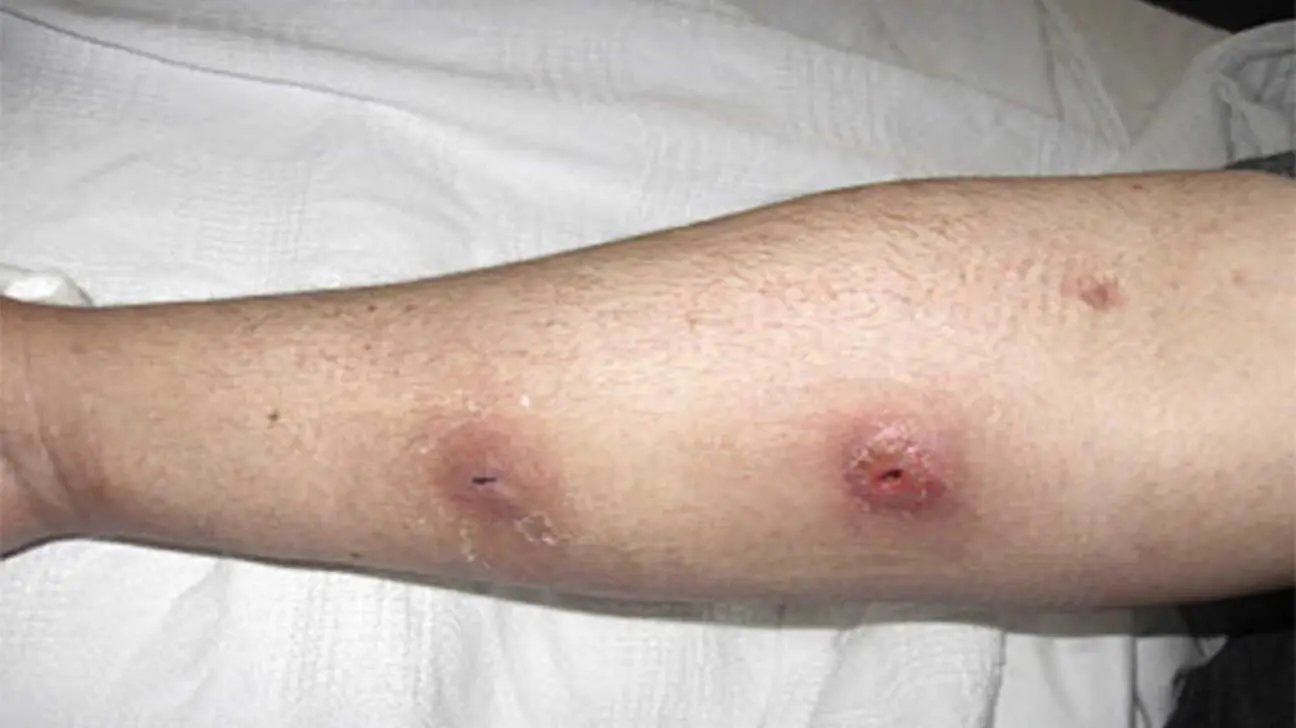
People that use heroin with intravenous needles are at an especially high risk of developing abscesses.
Usually caused by bacterial infections, an abscess is a built-up pocket of pus or fluid that is usually painful, red, and swollen.
Abscesses are dangerous if left untreated. Usually, a doctor will drain and clean an abscess to prevent the infection from spreading or becoming gangrenous (tissue death).
Infections can spread to the heart, bloodstream, and vital systems. Dead tissue may require amputation if left long enough. Infectious abscesses can be deadly.
Learn more about the signs of heroin use
Causes Of Heroin Abscesses
For people that inject heroin, the three primary contributing factors in acquiring an abscess include:
- using unhygienic injecting
- impure heroin
- having a compromised immune system
Any combination of these factors may increase the likelihood of getting an abscess, which is a common issue for those that use IV heroin.
Dirty Needles/Skin
People that use dirty needles to inject heroin are at a much higher risk of an abscess. Dirty skin or a nearby wound at the injection site increases incidences of an abscess.
A person that uses clean needles and uses sterile wipes at injection sites lowers the risk of infection substantially. However, IV drug use in itself is still a leading cause of heroin abscesses.
Impure Heroin
Because heroin is an illegal opioid, it lacks standardized laboratory processing. Heroin is often cut and mixed with bulking agents and other drugs. Some additives can worsen existing wounds and infections.
Weakened Immune System
People that chronically use heroin are typically at a greater risk for infection and secondary illness.
An IV heroin user that develops a skin infection may not have the immune strength to suppress it, and an abscess can develop.
What Does A Heroin Abscess Look Like?
Signs of a heroin abscess will appear near injection sites on the arms, legs, or feet.
They are typically round, red, and swollen — with a pus or fluid-filled center that can be a darker color. It may be foul-smelling and can ooze a cloudy, yellowish liquid.
A person with a heroin abscess may have swollen lymph nodes or a fever. The abscess will often be tender or painful to the touch.
Treatment For Heroin Abscesses
The standard treatment for heroin abscesses involves opening and draining the abscess.
After the abscess has been drained, antibiotics are usually prescribed to address the infection, which may have spread to other areas of the body.
Complications Of Heroin Abscesses
When abscesses are not appropriately addressed or treated in a timely manner, potentially deadly complications can arise.
Complications that may accompany heroin abscesses include:
- sepsis or septic shock: When a bacterial infection spreads beyond the abscess, sepsis and septic shock can result. When sepsis is left untreated, it can progress to septic shock. Organ failure and death may result from septic shock.
- endocarditis: Like sepsis, endocarditis happens when the bacterial infection from untreated abscesses progresses to the heart. This infection of the heart’s valves and lining is a common complication from prolonged heroin usage and can result in death.
- chronic abscesses: People that have used IV drugs for years may be more prone to recurrent abscesses. These abscesses happen around injection sites and continue to show up for as long as the person continues IV drug use.
- ulcers: An untreated abscess that breaks can become an ulcer that may lead to tissue death.
- gangrene: Untreated abscesses can cause tissue death, which can spread throughout the infected area. In some cases, bad scarring, further infections, or death can occur.
- amputation: Severe gangrene of a limb may kill off muscle and bone tissue to the point where amputation is the best way to stop the infection’s spread.
- osteomyelitis: When an infection from a heroin abscess or ulcer spreads to the bone, bone death can occur. This condition nearly always requires surgical intervention — including debridement or amputation.
Getting Help For Heroin Abuse
Heroin abuse creates casualties through countless pathways. If you or a loved one is struggling with heroin use, help is available.
Talk to one of our addiction treatment specialists today and learn about the range of inpatient and outpatient programs that specialize in heroin addiction treatment.
A life without opioid use is possible. Call today to get started.
Addiction Resource aims to provide only the most current, accurate information in regards to addiction and addiction treatment, which means we only reference the most credible sources available.
These include peer-reviewed journals, government entities and academic institutions, and leaders in addiction healthcare and advocacy. Learn more about how we safeguard our content by viewing our editorial policy.
- Clinical Infectious Diseases – Risk Factors for Skin and Soft-Tissue Abscesses among Injection Drug Users: A Case-Control Study
https://academic.oup.com/cid/article/33/1/35/316998 - Infectious Disease Clinics of North America — Skin and soft tissue infections in injection drug users
https://pubmed.ncbi.nlm.nih.gov/12371123/ - International Journal of Infectious Diseases — High prevalence of abscesses and self-treatment among injection drug users in Tijuana, Mexico
https://www.ijidonline.com/article/S1201-9712(10)02306-4/fulltext


